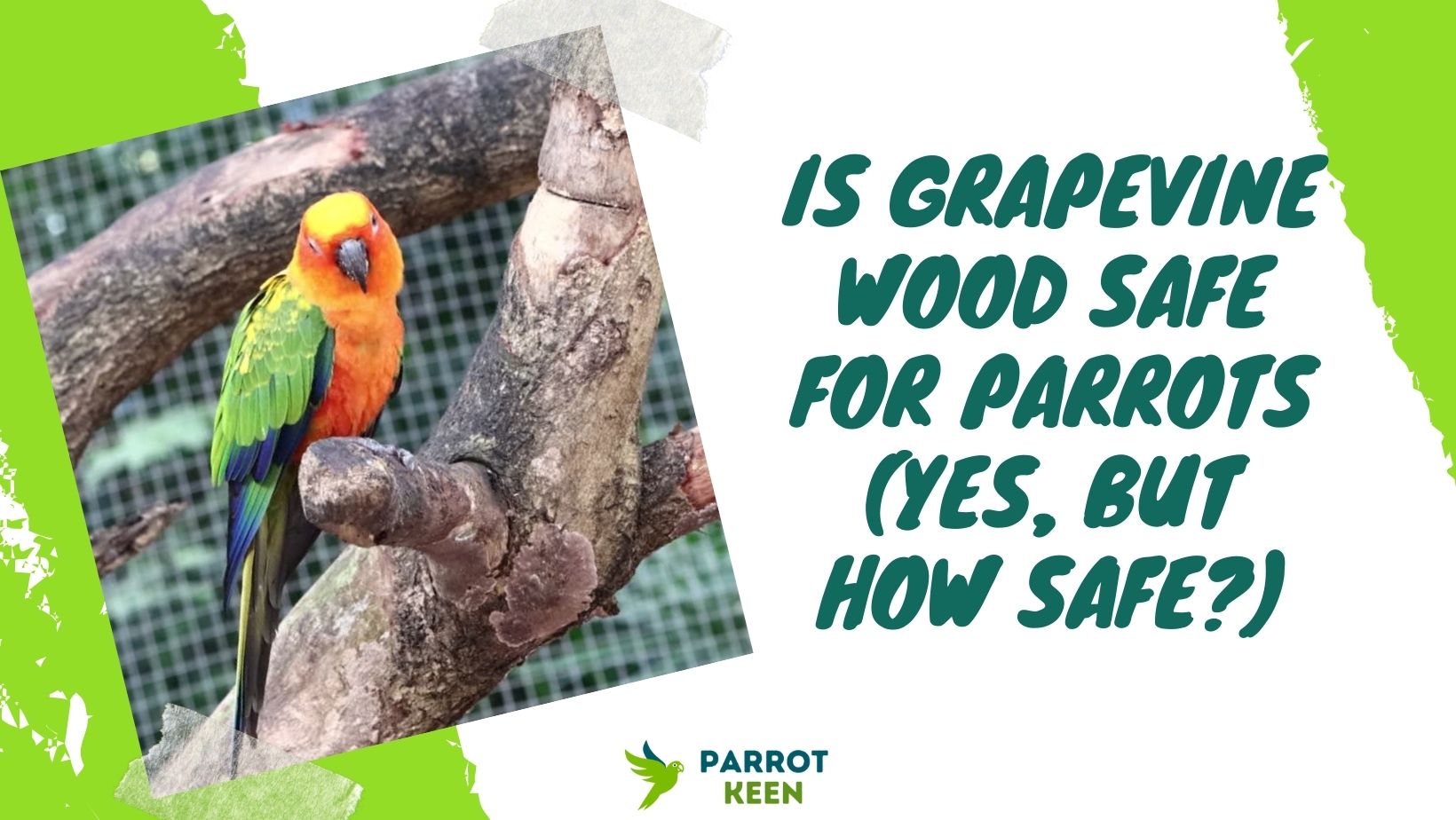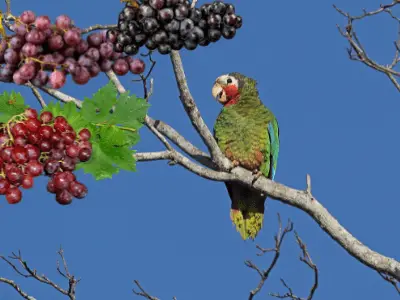
Is Grapevine Wood Safe for Parrots
You may wonder if Grapevine wood is safe for parrots if you’re a bird lover. In this blog post, we will closely examine the good and bad aspects of grapevine wood bird toys.
Parrots are beautiful creatures that can bring joy to any home. They are also brilliant and require a lot of stimulation to stay healthy and happy.
One way to provide this is by giving them bird toys made from grapevine wood. This type of wood is safe for parrots, but there are pros and cons to consider before purchasing.
If you’re a parrot lover, you know that finding safe and healthy bird toys can be tough. While many wooden bird toys are on the market, not all are safe for parrots. So, is grapevine wood safe for parrots? Let’s take a closer look.

Is grapevine wood safe for parrots?
Grapevine wood is a type of wood that is commonly used in bird perches. It is also a popular material for making bird toys.
Grapevine wood is safe for parrots to use; It has a natural look and feels. However, the bark of the grapevine is the only part of the plant that is toxic to birds.
Finding untreated Grapevine wood can be difficult. Most of the time, it is sold in pet stores that sell bird supplies. The wood is often treated with food-grade oil or chemicals to protect it from the elements.
The wood can be treated with pesticides that are not safe for Parrots. Pesticides can go deep in the wood, but it’s not always enough to guarantee you’ll remove all areas where they were spray-tested.
If you are unsure if the grapevine wood is safe for your parrot, you can always contact the manufacturer. Many pet stores will also have someone on staff that can answer your questions about grapevine wood safety.
When it comes to giving your parrot a perch made of grapevine wood, make sure that the diameter of the nest is no larger than half an inch.
What are the benefits of grapevine wood for parrots?
If you’re like most parrot owners, you want to provide your feathered friend with the best possible environment. This includes finding safe and sturdy toys and perches.
When it comes to perches, grapevine wood is a great option. But what are the benefits of grapevine wood for parrots? The benefits of grapevine wood for parrots are many.
Grapevines are a great source of natural enrichment for parrots. They can provide your bird with hours of fun and stimulation. Also, Grapevines are a great way to keep your parrot’s beak and nails healthy.
Grapevine wood is also a solid material. This means that it can withstand the wear and tear of your parrot’s claws.
Additionally, grapevine wood is less likely to splinter than other types of wood. This makes it a safe option for your parrot to chew on.
Overall, grapevine wood is an excellent choice for parrots. It is safe, strong, and provides many benefits for your bird. If you are looking for a new toy or perch for your parrot, consider grapevine wood. Your bird will thank you for it.
How do you know if your bird is safe around grapevine wood?
To know if grapevine wood is safe for your parrot, you’ll want to look for these three things:
- Signs that the vine was treated with chemicals
Chemicals used to preserve grapevines can be toxic to your parrot if ingested. Look for any signs that the wood has been treated, such as a label or sticker.
- Splinters and sharp edges
Grapevine wood can be quite brittle, so it’s important to check for splinters or sharp edges that could hurt your bird.
- Mould or mildew
Mold and mildew can also be dangerous for your parrot, so be sure to inspect the wood for any signs before letting your bird near it.
If you’re unsure whether or not grapevine wood is safe for your parrot, it’s always best to err on the side of caution and avoid it altogether. Plenty of other materials make great perches for your bird, so there’s no need to take unnecessary risks.
While grapevine wood can be a great addition to your bird’s cage, it’s essential to ensure it is safe before using it. By looking for these three things, you can help ensure your parrot stays healthy and happy.
Are there any risks associated with using grapevine wood as a bird toy or perch material?
Using Grapevine wood for bird toys and perches is a popular trend, but is it safe?
Grapevines are a type of woody vine that can grow very thick and strong.
They are often used in landscaping and provide excellent support for climbing plants. Grapevines are also very popular for use in making perches and bird toys. The wood is strong and has a natural appeal to birds.
However, there are some risks associated with using grapevine wood for bird toys and perches.
- One of the biggest dangers is that the vine can harbor bacteria and fungus. If the vine is not properly cleaned before use, it can cause an infection in your bird.
- Another danger is that the vine can be a choking hazard.
Birds can easily get their tongues or beaks caught in the gaps of the vine, which can lead to severe injury or even death.
It is important to take precautions when using grapevine wood for bird toys and perches.
Make sure to clean the vine thoroughly before using it, and avoid using it if your bird is prone to chewing on toys or perches.
If you use grapevine wood for your bird’s toys or perches, be sure to inspect them regularly for any signs of damage or wear.
Grapevine wood can be a great material for bird toys and perches, but it is important to be aware of its risks.
By taking some simple precautions, you can help keep your bird safe while still enjoying the benefits of this natural material.
How can you tell if your bird is getting sick from eating grapevine wood products?
There are a few things you can look for:
- Change in behavior: If your bird is suddenly lethargic or acting differently, it may signify that something is wrong.
- Change in appetite: A loss of appetite or sudden change in eating habits can also be a sign of illness.
- Weight loss: Sudden weight loss is another potential sign that your bird is not feeling well.
- Diarrhea: This is a common symptom of illness in birds and can be caused by various factors.
If you notice any of these changes in your bird, it’s important to take them to the vet right away. Grapevine wood products can be dangerous for birds if not used correctly, so it’s essential to be vigilant about your bird’s health.
List of Safe Trees and Woods For Parrots
Here are some safe wood for parrots
- Bamboo
Bamboos are giant grasses that grow in many tropical countries. There are more than 60 species of bamboo. Bamboos can be used as food, medicine, shelter, and construction material.
- Pine
Pines are a type of evergreen tree common in the Northern Hemisphere. There are more than 100 species of pine trees.
Pine trees can be used for parrots to chew on and play with. Pine is softwood, so it is not as hard on a parrot’s beak as other wood types.
Pine trees are also safe for parrots to eat. The needles of pine trees are a good source of Vitamin C for parrots.
- Lilac
The lilac is a flowering plant native to the mountainous regions of the Balkans. Lilacs can be used as a perch or climbing plant for your parrot. The wood is strong and durable, making it a good choice for larger birds. Lilacs are also known to have a high content of nectar, making them a great food source for your feathered friend.
- Hawthorn
The hawthorn is a common type of tree in Europe, Asia, and North America. Hawthorns can be used for making perches, toys, and other things for your parrot. The tree is safe for parrots to chew on and eat.
- Apple Tree
The apple tree is another type of tree that is safe for parrots. Apple trees are common in North America and Europe. Parrots can eat the leaves, bark, and fruit of the tree. The tree is also safe for parrots to chew on.
- Rosebush
The rose bush is a type of bush native to the temperate regions of the Northern Hemisphere. Rose bushes can be used for various purposes, including as ornamentals, for their fragrance, or for their fruit.
Rose bushes are generally safe for parrots, but there are a few things to keep in mind. The thorns on rose bushes can pose a hazard to parrots if they get tangled.
Also, some types of rose bushes are treated with pesticides or other chemicals that can be toxic to parrots. If you are unsure whether a particular type of rose bush is safe for your parrot, it is best to err on the side of caution and avoid it.
However, rose bushes are safe for parrots and can make a beautiful addition to your home. Just be sure to choose an appropriate variety for your climate and keep an eye out for thorns.
With a little bit of care, your rose bush will be a beautiful and safe addition to your parrot’s home.
- Beech
The beech is a common type of tree in Europe and North America. Beeches can be used for perches, nesting boxes, and toys. Beech is a hardwood that is strong and durable.
- Spruce
Spruce is a softwood common in many parts of the world, and it’s one of the most popular woods used in bird perches. It’s a good wood for parrots to chew on, and it’s also absorbent, so it helps keep your bird’s nails clean and healthy.
However, spruce does have some drawbacks. It can be very dusty, and the dust can irritate your bird’s respiratory system. It’s a softwood, so it won’t last as long as some of the harder woods on this list. If you choose to use spruce in your bird’s cage, make sure to clean it often and replace it when it starts to show signs of wear.
Conclusion: Is Grapevine Wood Safe for Parrots?
Grapevine wood is a popular choice for bird perches. So far, there doesn’t seem to be any evidence that grapevine wood is harmful to parrots. Some studies suggest that the grapevine may even have some health benefits for birds.
However, more research is needed to confirm these findings. If you’re thinking about using grapevine wood as a perch for your parrot, keep an eye on your bird and watch for any signs of distress.

